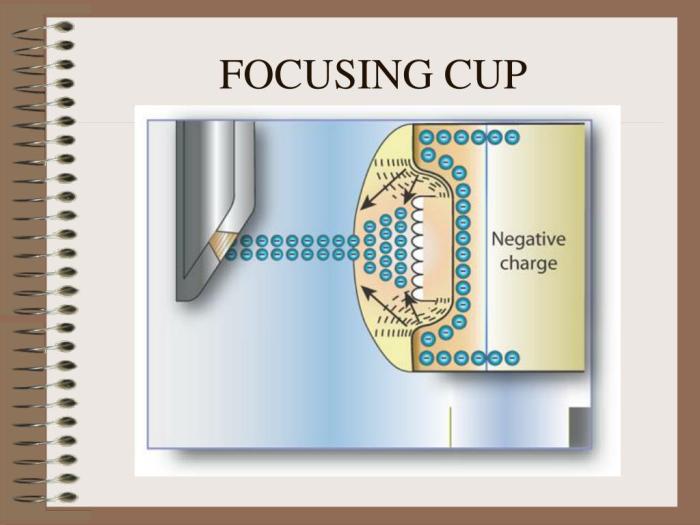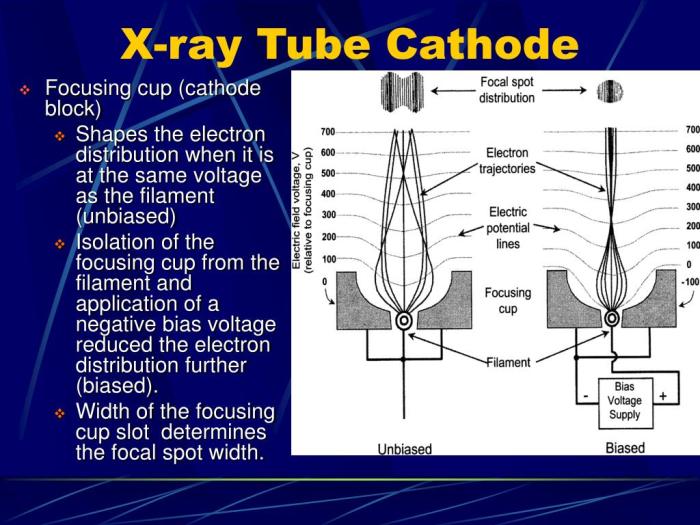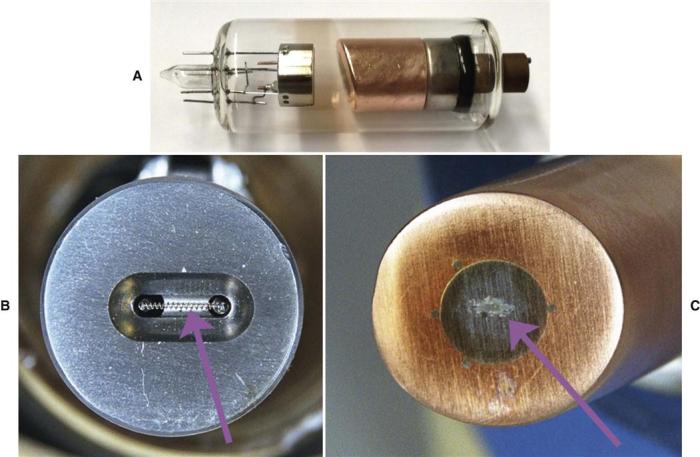Focusing cup x ray tube – Step into the realm of focusing cup x-ray tubes, where precision meets innovation. These remarkable devices harness the power of focused electron beams to generate high-quality x-rays, revolutionizing medical imaging, industrial inspections, and scientific research.
As we delve into the intricacies of focusing cup x-ray tubes, we’ll explore their unique design, unravel the secrets of x-ray generation, and uncover their invaluable applications across diverse fields.
Focusing Cup X-Ray Tube Overview

A focusing cup x-ray tube is a type of x-ray tube that utilizes a specially designed cathode to focus the electron beam onto a small focal spot. This results in the production of a more intense and collimated x-ray beam compared to conventional x-ray tubes.The
focusing cup x-ray tube consists of a heated cathode that emits electrons, an anode target where the electrons are accelerated and interact with, and a focusing cup that surrounds the cathode. The focusing cup is typically made of a high-conductivity metal such as copper or molybdenum and is shaped to converge the electron beam towards the focal spot on the anode.
This focused electron beam produces x-rays when it strikes the anode target.The materials used in the construction of a focusing cup x-ray tube are carefully selected based on their properties. The cathode is typically made of tungsten or rhenium due to their high melting points and low vapor pressures.
The anode target is usually made of a heavy metal such as tungsten or molybdenum to withstand the high energy electron bombardment and produce efficient x-ray emission. The focusing cup is made of a high-conductivity metal to minimize energy loss and ensure efficient electron focusing.
Focusing cup x ray tubes are essential for producing sharp and clear images in radiography. While they are not directly related to the topic of AICE US History Paper 2, you can learn more about this topic by clicking on the provided link.
Nevertheless, understanding the principles of focusing cup x ray tubes is crucial for anyone working in the field of medical imaging.
Focusing Mechanism and Electron Beam

The focusing cup x-ray tube employs a sophisticated mechanism to focus the electron beam and generate x-rays. This mechanism is crucial for achieving a sharp and precise focal spot, which determines the image quality in x-ray applications.
The electron beam is generated by a heated cathode, which emits electrons through thermionic emission. These electrons are then accelerated towards a positively charged anode, which is shaped like a cup. The anode’s cup-like structure serves as an electrostatic lens, focusing the electron beam as it passes through the aperture at the base of the cup.
Factors Affecting Focal Spot Size and Intensity
The focal spot size and intensity in a focusing cup x-ray tube are influenced by several factors:
- Anode Voltage:Higher anode voltages accelerate the electrons more, resulting in a smaller focal spot size and higher intensity.
- Electron Beam Current:Increasing the electron beam current leads to a larger focal spot size but also higher intensity.
- Anode Material:The atomic number of the anode material affects the intensity and quality of x-rays produced. Tungsten is commonly used for its high atomic number and thermal stability.
- Focal Spot Design:The shape and size of the focal spot are determined by the anode’s geometry and the focusing mechanism. A smaller focal spot produces sharper images but has lower intensity.
X-Ray Generation and Characteristics: Focusing Cup X Ray Tube

In a focusing cup X-ray tube, X-rays are generated when a focused electron beam strikes a metal target (anode).
The process begins with the emission of electrons from a heated cathode. These electrons are accelerated towards the anode by a high voltage, typically ranging from 20 to 150 kV.
Electron Beam Focusing
The focusing cup, located around the cathode, focuses the electron beam into a narrow, pencil-like shape. This focused beam is directed towards the anode, where it interacts with the target material.
X-Ray Generation
As the electron beam strikes the anode, it undergoes sudden deceleration, resulting in the emission of X-rays. This process is known as bremsstrahlung radiation.
The energy of the emitted X-rays is determined by the accelerating voltage applied to the electron beam. Higher voltages produce X-rays with higher energy.
X-Ray Characteristics
The X-rays produced by a focusing cup X-ray tube exhibit the following characteristics:
- Energy:The energy of the X-rays ranges from a few keV to hundreds of keV, depending on the accelerating voltage.
- Intensity:The intensity of the X-rays is proportional to the electron beam current and the atomic number of the anode material.
- Beam Profile:The focused electron beam results in a narrow, pencil-like X-ray beam with a small focal spot size.
Factors Influencing X-Ray Output
The output and quality of the X-rays generated are influenced by several factors, including:
- Accelerating Voltage:Higher voltages produce X-rays with higher energy and penetration.
- Electron Beam Current:Higher currents result in higher X-ray intensity.
- Anode Material:The atomic number of the anode material affects the intensity and energy distribution of the X-rays.
- Target Angle:The angle of the anode target relative to the electron beam can affect the X-ray beam profile.
Applications and Industrial Uses

Focusing cup x-ray tubes are widely used in various industries due to their ability to produce high-intensity, focused x-rays. Their applications span across a diverse range of fields, including medical imaging, industrial radiography, and scientific research.
Medical Imaging
In the medical field, focusing cup x-ray tubes are commonly employed in diagnostic imaging procedures such as fluoroscopy, mammography, and computed tomography (CT) scans. The precise and concentrated beam of x-rays allows for detailed visualization of internal structures, aiding in the detection and diagnosis of various medical conditions.
Industrial Radiography
Within the industrial sector, focusing cup x-ray tubes are extensively utilized for non-destructive testing (NDT) applications. They are used to inspect welds, castings, and other components for defects and flaws. The ability to focus the x-ray beam enables the detection of even minute imperfections, ensuring the structural integrity and safety of various products.
Scientific Research, Focusing cup x ray tube
In scientific research, focusing cup x-ray tubes play a crucial role in materials characterization and crystallography. The intense and concentrated beam of x-rays allows for precise analysis of crystal structures, chemical composition, and material properties.
Potential Future Applications and Advancements
The future holds promising advancements for focusing cup x-ray tube technology. Ongoing research and development efforts are focused on enhancing the efficiency and performance of these tubes. Miniaturization of the tubes, improved beam quality, and increased power output are some of the areas of active exploration.
As technology continues to progress, focusing cup x-ray tubes are expected to find applications in new and emerging fields, such as microelectronics, nanoscale imaging, and even space exploration.
Question Bank
What is the purpose of a focusing cup in an x-ray tube?
The focusing cup confines and shapes the electron beam, directing it towards a smaller focal spot, resulting in improved image resolution and reduced scatter radiation.
How does the focusing mechanism affect x-ray output?
The focusing mechanism influences the intensity and focal spot size of the x-rays. A tighter focus produces higher intensity and smaller focal spot, leading to sharper images.
